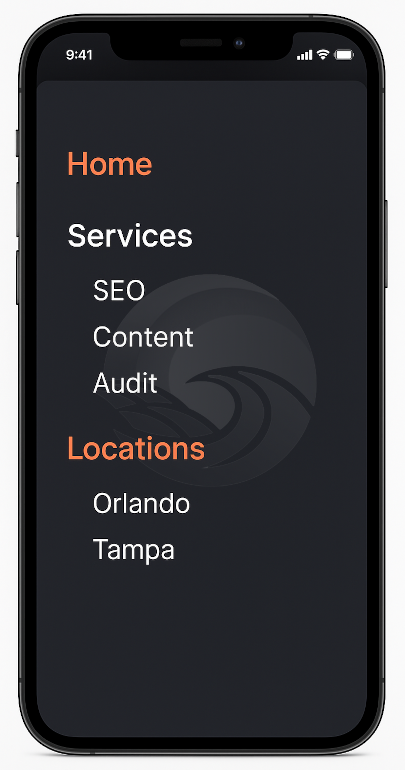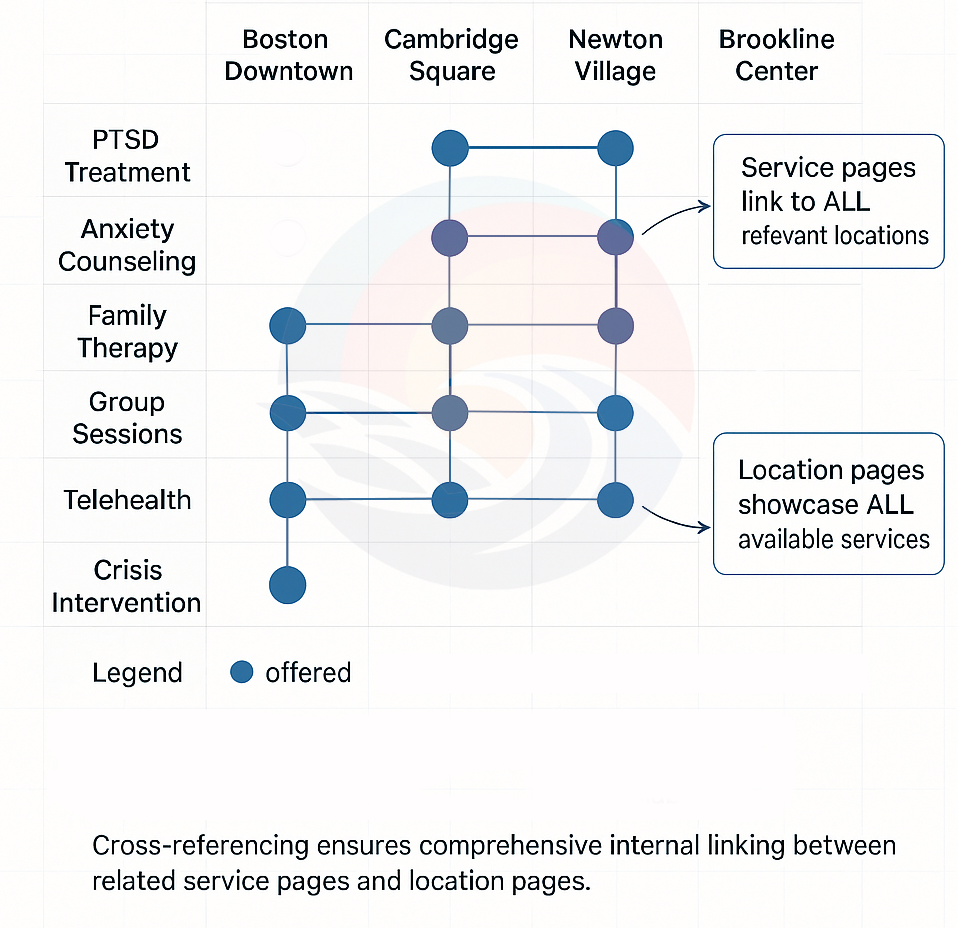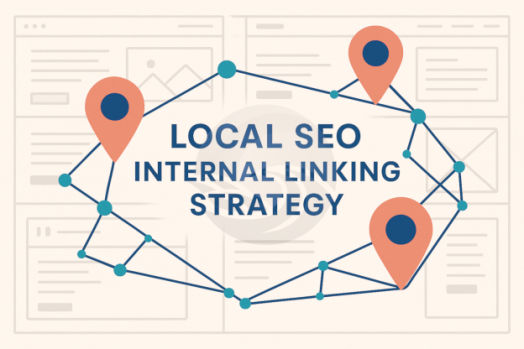Many local SEO strategies focus on external signals like citations, reviews, profile optimization. But businesses dominating local search results have something else in common: internal linking architecture that connects locations and services strategically.
Internal linking and local visibility deserve more attention. Most businesses treat internal links as navigational afterthoughts, but smart operators leverage link architecture as a strategic asset for search engines and discovery systems.
This article explores how internal linking works within local SEO, examines what matters technically, and provides a framework you can implement.
Mobile-First Context and User Behavior Patterns
Google’s mobile-first indexing changed how we approach internal linking for local businesses. The shift reflects user behavior patterns where local searches happen on mobile devices with immediate commercial intent.
This context influences internal linking strategy:
- Navigation complexity must decrease: Mobile users prefer simpler paths to location details, contact methods, and service availability.
- Loading performance becomes critical: Internal links that slow page loading create friction points that impact user experience and search performance.
- Touch-friendly implementation matters: Internal links need adequate spacing and sizing for mobile interaction, which influences placement and frequency decisions.

Internal linking for local businesses must serve discovery functions while maintaining mobile usability a balance that requires more planning than traditional linking approaches.
Hub and Spoke Architecture: A Systematic Approach
The most effective internal linking strategy for local businesses follows a hub and spoke model that distributes authority while maintaining clear user pathways. This approach works because it mirrors how users actually think about local business relationships and the central services offered at specific locations.

Primary Authority Distribution
The foundation involves connecting your homepage to major category pages and location hubs. Rather than linking directly from the homepage to every individual service at every location, you create clear hierarchical pathways that both users and search engines can follow logically.
This typically means:
- Homepage connects to main service categories
- Homepage connects to as locations overview page
- Service categories connect to specific service pages
- Locations overview connects to individual location pages
Secondary Relationship Building
Relationships develop between service pages and location pages, creating cross-connections that reflect business operations. A service offered at multiple locations should link to all relevant location pages, while location pages should link to all services available at that location.
This creates “service-location intersections”, pages or sections that help users understand what’s available where, while providing search engines with clear signals about geographic and topical relevance.
Geographic Clustering Considerations
For businesses with multiple locations, geographic clustering prevents internal linking from becoming unwieldy while maintaining local relevance signals. Rather than every location linking to every other location, group nearby locations and create stronger internal linking relationships within those geographic clusters.

This approach works for businesses serving large metropolitan areas where locations serve different micro-markets despite offering similar services.
Google Business Profile Integration Strategy
The relationship between your Google Business Profile and internal linking strategy deserves attention, as many businesses miss connection opportunities.
Profile-to-Website Flow: Your Google Business Profile should direct users to location-specific landing pages rather than homepages. These landing pages become hubs for internal linking to services and related locations.
Website-to-Profile Connections: Internal pages should link back to Google Business Profiles when appropriate, particularly for driving direction requests and phone calls. This creates an ecosystem where your website and profile reinforce each other.
Consistency Requirements: NAP (Name, Address, Phone) information must remain consistent between your Google Business Profile and all internal pages that display location information. Inconsistencies can undermine the authority signals you’re building through internal linking.
The goal is creating seamless transitions between Google’s local search interface and your website’s internal structure, making it easy for users to move between platforms.
Topic Authority for Local Context
Traditional topic cluster strategies require adaptation for local businesses, where the challenge involves building topical authority while maintaining location-specific relevance. The solution involves consolidating topic authority rather than fragmenting it across location variations.
Instead of creating separate topic cluster pages for each location, create one authoritative page per service or topic, then use internal linking to connect that authority to all locations. This avoids duplicate content issues while building stronger topical signals.
Example Structure:
- Create one comprehensive page about a specific service
- Link that page to all location pages where the service is available
- Use location-specific anchor text when linking
- Include natural mentions of all service locations within the topic content
- Ensure each location page links back to the authoritative service page
This approach concentrates authority into fewer, stronger pages while maintaining clear location relationships through internal linking patterns.
Schema Markup Integration
Your internal linking strategy should align with structured data implementation, particularly for local business schema. When you link between location pages and service pages, the schema markup should reflect those relationships.
LocalBusiness schema can specify services offered, operating locations, and other details that mirror your internal linking structure. This creates consistency between what search engines see through crawling your links and what they understand through structured data.
Ready to analyze your internal linking structure?
Multi-Location Strategy Without Cannibalization
For businesses operating multiple locations, the challenge involves building location-specific authority without creating keyword cannibalization between locations. This requires thinking about how locations relate to each other and to the services they offer.
Geographic Differentiation
Rather than having all locations compete for the same keywords, assign geographic targets based on service areas and competitive landscapes. This doesn’t mean locations can’t share some keyword targets, but it means being deliberate about optimization focuses.
Service Specialization
Multi-location businesses find success in emphasizing different service strengths at different locations, which creates different internal linking patterns and keyword optimization opportunities.
The key is understanding that internal linking between locations should reflect business relationships rather than attempting to game search algorithms through artificial cross-linking.

Measurement and Optimization
Effective internal linking for local SEO requires systematic measurement to understand what’s working and what needs adjustment. Unlike some SEO tactics that show results quickly, internal linking often requires patience and consistent monitoring.
Key Performance Indicators
Local keyword rankings provide the most direct measure of internal linking effectiveness, particularly when tracked at the location level rather than just business level.
Google Business Profile analytics can show how website clicks from your profile change as internal linking improves the user experience on your location pages.
Internal traffic flow through Google Analytics helps identify which internal linking patterns actually guide users toward conversion actions.
Monitoring Tools and Approaches
Google Search Console provides location-specific query data that can help you understand whether your internal linking strategy supports the local searches you want to rank for.
Site auditing tools can identify broken internal links, over-optimization patterns, and opportunities for better internal link distribution.
Regular review of user behavior data helps ensure your internal linking serves real user needs rather than just theoretical SEO benefits.
Common Implementation Mistakes
Over-Complication
Many businesses create unnecessarily complex internal linking schemes that confuse both users and search engines. Simple, logical patterns usually work better than linking strategies.
Over-Optimization
Using exact-match keywords for all internal anchor text appears unnatural. Natural language variations and branded anchor text work better.
Ignoring Intent
Internal links should guide users toward information they actually want to access. Linking strategies that prioritize search engines over user experience typically under perform in the long term.
Inconsistent Implementation
Starting internal linking initiatives without systematic implementation often leads to partial execution that doesn’t provide the full benefits of a coordinated approach.
Practical Implementation Examples
Understanding internal linking strategy requires seeing it in action. Here are specific examples of how effective internal linking works for different types of local businesses:
Example 1: Multi-Location Healthcare Practice
Business Structure: Therapy practice with locations in Boston, Cambridge, and Newton offering PTSD treatment, anxiety counseling, and family therapy.
Homepage Internal Links:
"Our Services" → /services/ (service hub page)
"Find a Location" → /locations/ (location hub page)
"PTSD Treatment" → /services/ptsd-treatment/
Service Page Internal Links (/services/ptsd-treatment/):
"Available at our Boston location" → /locations/boston/
"Also offered in Cambridge" → /locations/cambridge/
"Newton office specializes in trauma therapy" → /locations/newton/
"Learn about our anxiety counseling" → /services/anxiety-treatment/
Location Page Internal Links (/locations/boston/):
"PTSD treatment in downtown Boston" → /services/ptsd-treatment/
"Anxiety counseling services" → /services/anxiety-treatment/
"Family therapy sessions" → /services/family-therapy/
"Visit our Cambridge location" → /locations/cambridge/Key Pattern: Each service connects to all relevant locations, and each location connects to all available services, creating comprehensive cross-linking without keyword stuffing.
Example 2: Service Area Business
Business Structure: HVAC company serving Greater Boston area from single location but working in multiple cities.
Service + Area Combination Pages:
/hvac-repair/boston/ (specific service in specific area)
/hvac-repair/cambridge/
/hvac-repair/newton/
Internal Linking Strategy:
Main service page (/hvac-repair/) links to all area-specific variations
Area-specific pages link back to main service page
Area pages cross-link to nearby service areas
Include relevant local content (weather patterns, common HVAC issues in older Boston homes)Example 3: Retail Chain with Geographic Clustering
Business Structure: Pet supply store with 8 locations across Massachusetts.
Geographic Clusters:
Greater Boston: Boston, Cambridge, Somerville
MetroWest: Newton, Wellesley, Natick
North Shore: Salem, Beverly
Hub Pages:
/locations/greater-boston/ (cluster hub)
/locations/metrowest/ (cluster hub)
/locations/north-shore/ (cluster hub)
Internal Linking Pattern:
Homepage links to three cluster hub pages
Cluster hubs link to individual locations within cluster
Individual locations cross-link only within their cluster
Service pages link to relevant cluster hubs, not individual locationsWillDoSEO.com

